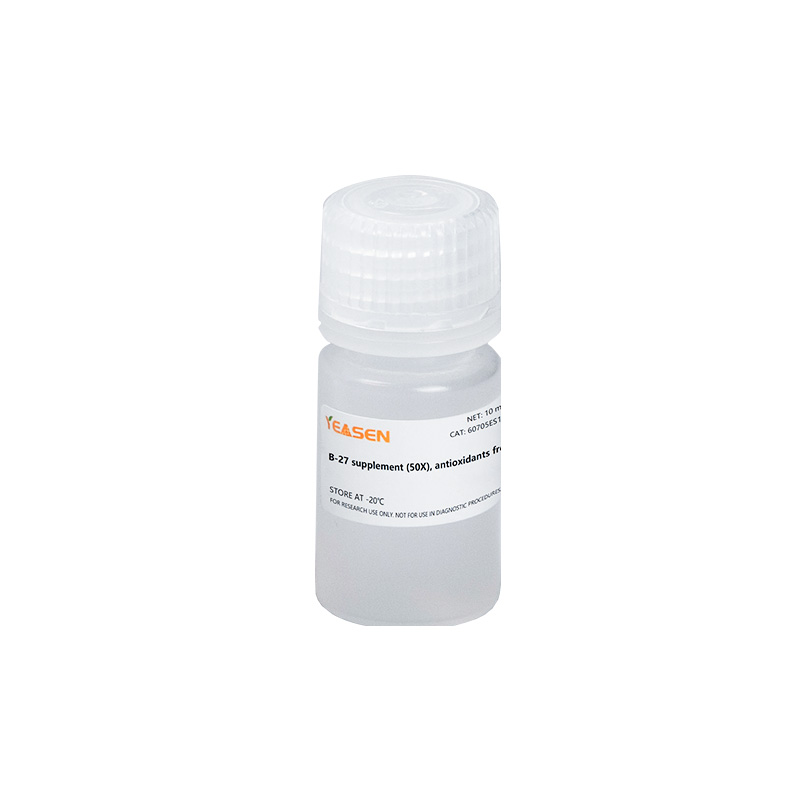NSC-27 supplement without Antioxidant, serum free, 50X(same as B-27)
Product description
NSC-27, one of the most frequently cited neural cell culture supplements, is a serum-free supplement optimized to support the growth of embryonic, postnatal, and adult hippocampal neurons and other central nervous system (CNS) neurons. The NSC-27 Serum Free Supplement is supplied as a 50X working solution and is designed to be used with Neurobasal Medium, which is used for neuronal cell culture without the need for an astrocyte feeder layer. Use NSC-27 Supplement in Neuronal Basal Medium for culturing prenatal and embryonic neurons for optimized viability and long-term survival.
NSC-27 can replace B-27 supplement.
60703ES is NSC-27 supplement, serum free, 50X and 60704ES is NSC-27 supplement without Vitamin A, serum free, 50X. 60704ES removes Vitamin A, which prevents the differentiation of neural stem cells into neural cells. 60705ES is NSC-27 supplement without Antioxidant, serum free, 50X. 60705ES removes antioxidants to facilitate the interference of antioxidants in the study of oxidative stress and damage, oxygen free radicals on nerve damage and apoptosis.
Specifications
|
Cat.No. |
60705ES10 |
|
Size |
10 mL |
|
Appearance |
liquid |
Components
|
.T3 .Putrescine |
.l-carnitine .Putrescine |
.Insulin .D(+)Galactose |
|
.Linoleic Acid .Oleic acid .Lipoic acid .Retinol acetate |
.Linolenic Acid .Biotin .Corticoseterone .Ethanolamine |
.Progesterone .Pipecolic acid .Bovine Transferrin(HOLO) |
Storage
This product should be protected from light at -25~-15℃ for 2 years.
Instructions
The NSC-27 cell culture additive is 50X working solution. Please dilute to 1X with basal medium (as Neurobasal) before using. 1 mL of NSC-27 cell culture additive (50X) was added to 49 mL of basal medium if preparing 50 mL of medium. The configured culture medium can be stored away from light at 2~8℃ for 1 week.
- Complete medium preparation
- Thaw this product at 4°C.
- Aseptically add 2 % of this product and 0.5 mM L-glutamine to neuronal basal medium before use to prepare neuronal complete medium (Note: " Neuron complete medium " appears hereinafter refers to this Neuronal basal medium supplemented with NSC-27 Supplement and L-Glutamine) Note: The remainder of this product can be aliquoted into working volume and stored at -30°C~-5°C. Defrost appropriate volumes of this product as needed in future experiments. Avoid repeated freezing and thawing.
- For primary hippocampal neuron cultures, neuronal complete medium (prepared from previous steps) requires an additional supplement of 25 L-glutamic acid in μM, no glutamic acid should be added in the medium change after the 4th day of culture. The prepared complete medium can be stored at 2-8°C for a week in the dark.
- Cell culture steps
The following procedure has been tested in rat fetal primary hippocampal and cortical neurons, as well as in neuroblastoma cell lines.
- Coat the culture surface (glass or cell culture grade plastic) with sterile cold 0.05 mg/mL poly-lysine aqueous solution, using 0.15 mL per square centimeter of surface, and incubate for 1 h at room temperature.
- The poly-lysine solution was removed and rinsed twice with sterile distilled water (must be washed thoroughly because poly-lysine is toxic to cells). Open the lid of the culture plate in a clean bench to ventilate until each well is completely dry. Plates can be used immediately after drying or stored at 4°C for up to 2 weeks.
- Isolate primary rat neurons or thaw cryopreserved primary rat neurons according to standard laboratory procedures or the instructions provided with the cells.
- Cells were seeded in pre-warmed (37°C) neuronal complete medium (prepared as previously described) at a recommended cell density of 160 cells/ mm 2 or a self-optimized cell density if necessary. Note: For hippocampal neurons, the medium must be supplemented with 25 μM L-glutamic acid, see "Preparation of complete medium " .
- Incubate at 36°C to 38°C in a humid environment with 5% carbon dioxide (natural air is also acceptable, but a gas environment with 9% oxygen and 5% carbon dioxide is recommended).
- After 4-24 hours of culture, replace with half the volume of fresh medium and continue culturing in the incubator.
- For cells other than hippocampal neurons: 4 days after seeding, replace with half the volume of fresh complete medium and repeat every three days thereafter. For hippocampal neurons: Three days after seeding, replace half the volume of medium with fresh medium without L-glutamate. Repeat every three days thereafter. Note: in complete medium add 25 µM 2-mercaptoethanol, which improves long-term survival of hippocampal neurons.
- Isolation of primary rat embryonic neurons
The following procedure is recommended for culturing rat embryonic hippocampal neurons and cerebral cortical neurons on day 18 of fertilization.
- Isolation of cerebral cortex and bilateral hippocampus from 18-day fertilized rat embryos
- All tissues were collected in conical tubes prefilled with Hibernate-E complete medium. Place until all tissue has disintegrated.
- The tissue was allowed to settle to the bottom of the tube, and the supernatant was carefully removed, leaving a minimal amount of medium just enough to cover the tissue.
- In calcium-free Hibernate-E medium, use a 2 mg/mL filter-sterilized papain solution to digest tissue at 30°C for approximately 30 min, with gentle shaking of the conical tube every 5 mins to aid degradation. Use 2 mL of enzyme solution per pair of hippocampal tissue.
- Add twice the volume of Hibernate-E complete medium to restore the concentration of divalent cations and stop the digestion.
- Allow undissociated tissue to settle to the bottom of the tube (about 2 mins), then transfer the supernatant to a 15 mL centrifuge tube and centrifuge at 150 x g for 5 mins.
- Resuspend the pellet in 1 mL of neuronal complete medium and take an aliquot (e.g., 10 μL) for cell count. Follow steps 8-10 in " Resuscitation and Culture of Cryopreserved Neurons“.
- Resuscitate and culture cryopreserved neurons
IMPORTANT: Primary neuronal cells will adhere to exposed plastic or glass surfaces, and it is recommended to rinse all plastic and glassware inner surfaces with neuronal complete medium prior to obtaining the highest recovery and yield. Since cells are extremely fragile when recovered from cryopreservation, do not shake or centrifuge cells throughout the procedure. We recommend thawing only one tube of cells at a time. Be sure to reduce the time required to transfer cryovials from liquid nitrogen to a 37°C water bath. During the transportation of cells from the liquid nitrogen tank to the water bath, a small amount of liquid nitrogen can be placed in an ice bucket, and the cells can be placed in this ice bucket.
- Before thawing cells, rinse a sterile 15 mL conical tube with neuronal complete medium, then ventilate to dry on an ultra-clean bench.
- When removing the cryovial from the liquid nitrogen, loosen the cap slightly to relieve pressure, and then tighten again.
- Gently agitate the cryovial in a 37°C water bath to thaw the cells quickly (less than 2 mins). Remove from the water bath when only a few ice crystals are observed in the vial (the vial still feels cold to the touch).
- Sterilize cryovials with 70% isopropanol in a clean bench. Tap the cryovials gently on the work surface to allow the liquid to settle to the bottom of the tube.
- Using a 1 mL pipette tip previously rinsed and dried with neuronal complete medium, transfer cells very gently into a previously rinsed and dried 15 mL conical tube.
- Rinse the cryovial with 1 mL of pre-warmed neuronal complete medium and add very slowly to the cells in the 15 mL conical tube at a rate of one drop per second. Gently turn the conical tube once after each drop is added. Do not add all the medium to the conical tube at once.
- An additional 2 mL of prewarmed complete medium was added drip by drip so that the volume of liquid in the tube was 4 mL. Gently mix the liquid with a 1 mL suction head with care not to cause any bubbles.
- Pipette 10 μL of the cell suspension into a microcentrifuge tube containing 10 μL of 0.4% trypan blue using a previously rinsed and dried pipette tip, and tap the tube wall to mix the solution. Viable cell density was determined using a manual cell counting method. Thawed cells should be more than 50% viable.
- Approximately 1×105 cells per well or at the desired cell density in a 48-well plate that has been previously coated with poly-lysine (refer to “Cell Culture Procedure“). The cell suspension was diluted to 500 μL per well by adding prewarmed neuronal complete medium.
- Follow steps 5-6 in "Cell Culture Procedures" to culture neurons. Incubate at 36 °C to 38 °C in a humid environment with 5% carbon dioxide (natural air is also acceptable, but a gas environment containing 9% oxygen and 5% carbon dioxide is recommended).
Notes
1. This product is for research use only.
2. Please operate with lab coats and disposable gloves,for your safety.
Ver.EN20240318
Catalog No.:*
Name*
phone Number:*
Lot:*
Email*
Country:*
Company/Institute:*
Related articles

